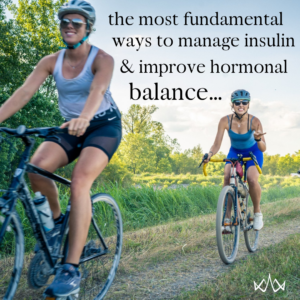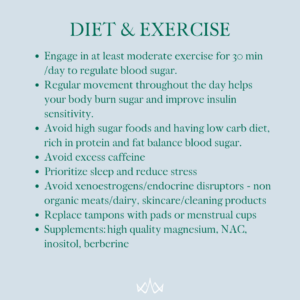[vc_row][vc_column width=”1/6″][/vc_column][vc_column width=”2/3″][vc_video link=”https://youtu.be/cIINfW_SMFg”][vc_column_text]
Polycystic Ovarian Syndrome
Known as PCOS, this condition can happen at any age after puberty. Every month, as part of a healthy menstrual cycle, the ovaries release an egg. In women that have PCOS, the ovaries will develop a thickened outer wall underneath which many partially stimulated eggs form cysts, hence the name polycystic ovarian syndrome.
Normally, the ovaries release a small amount of male sex hormones, called androgens. However, in women with PCOS, the ovaries start making slightly more androgens – which is the reason for masculine symptoms like extra facial and body hair and male pattern baldness.
Traditionally, the diagnosis of Polycystic Ovarian Syndrome was made when an imaging study revealed multiple cysts on the ovaries. We now know not every woman diagnosed with polycystic ovarian syndrome has visible cysts on her ovaries. Polycystic ovarian syndrome can still be diagnosed if the majority of other common symptoms are experienced and/or they have the common endocrine abnormalities associated with PCOS. This is because the “cysts” are actually just increased number of follicles.
How Do I Know If I Have PCOS?
Pay attention to your body! Your body is wonderfully and brilliantly made. It will tell you if something is off. At the start of your next cycle, pay attention to these signs.
Symptoms of PCOS:
- Trouble getting pregnant (infertility)
- Irregular menstrual cycle
- Hirsuitism, with hair growth on the face, chin, or parts of the body where men usually have hair
- Acne on the face, chest, and upper back
- Thinning hair or hair loss on the scalp; male-pattern baldness
- Weight gain or difficulty losing weight
- Darkening of skin, particularly along neck creases, in the groin, and underneath breasts, which is commonly associated with insulin resistance
- Anxiety and depression
- Elevated waist to hip ratios, overweight and obesity
- Fatigue
What Causes PCOS?
While the exact cause of PCOS is unknown, several factors, including genetics, diet, stress levels, and environmental toxins can all play a role because they influence your hormones. The common hormonal imbalances associated with PCOS include high androgens (testosterone/DHEA), overproduction of CRH (corticotropin releasing hormone) and cortisol, elevated insulin/glucose levels, elevated estrone levels and improper ratios of LH (lutenizing hormone) to FSH (follicle stimulating hormone).
High insulin is not just a symptom, it is a major driver.
Can I Treat PCOS Naturally?
Things you can do to improve hormone balance and reduce PCOS:
- Avoid high sugar foods and having low carb diet, rich in protein and fat balance blood sugar.
- Avoid excess caffeine
- Prioritize sleep and reduce stress
- Avoid xenoestrogens/endocrine disruptors – non organic meats/dairy, skincare/cleaning products
- Replace tampons with pads or menstrual cups
- Supplements: high quality, recommended magnesium, NAC, inositol, berberine
- Red light laser therapy (photobiomodulation)
Here’s What You Can Do Today
Better Food and Finding a Healthy Weight if Overweight
Consuming a nutrient-dense, low-glycemic diet will improve insulin sensitivity, body composition and androgen levels. In the Journal of Obesity, participants followed a low starch/low dairy food plan for 8 weeks, which resulted in a decrease in testosterone, improved insulin sensitivity and weight loss. In addition, there may be some association with improper detoxification and bodily retention of environmental toxins in patients with PCOS. We suggest most patients consume a whole foods diet, limiting exposure to pesticides, preservatives, and artificial sweeteners. Include a plethora of non-starchy vegetables, grass-fed/pasture-raised meat/poultry, wild-caught fish (salmon is my favorite), nuts/seeds and unrefined oils/fats like coconut oil, olive oil and avocado.
Stress Management
Increased stress will elevate your cortisol levels which in turn elevates blood glucose levels. This will lead to increased weight gain around the abdomen as well as an increase in androgen levels. Excess androgen levels can lead to aromatization and an increase in estrone levels created by the increase in adipose (fat) tissue. Elevated estrone levels disrupt the proper ratios of LH and FSH that lead to menstrual irregularities and the many other symptoms associated with PCOS. Many patients admit to experiencing stress in their lives, however, most are not aware of the real physiological changes that occur when they feel stressed.
Some suggestions for reducing stress are to spend more time in nature, try mindful movement, breathing, and meditation a few times per week. Start a heart-centered meditation, engage in daily prayer, start a journal and ensure that you are getting proper sleep (at least 7-9 hours per night). Other suggestions include acupuncture, energy therapy such as marma therapy, massage and/or chiropractic.
Exercise
Getting regular movement is part of any treatment plan for patients diagnosed with PCOS. It is important to engage in moderate activity to improve body composition, burn fat and lower cortisol levels. Some women make the mistake of engaging in extremely intense activity, which can actually cause more hormonal imbalances. As a general rule, we recommend listening to your body and paying attention to how you feel during and after your exercise routine.
Herbal Medicine
Herbs known as adaptogens can help promote hormone balance and protect the body from the effects of cortisol caused by chronic stress. Ashwaganda, holy basil, rhodiola and maca root can are a few of the herbs that can be helpful in PCOS. Licorice can lower testosterone levels, however, care must be taken if you also have hypertension. Inositol is another commonly used supplement to improve symptoms associated with PCOS, although it seems to be more helpful in the patients that are not classified as obese. There are two types of inositol: myo-inositol and D-chiro-inositol and doses somewhere between 1,200-2,400 milligrams per day can help with follicular maturation, weight loss, reducing leptin levels , lowering triglyceride levels and improving HDL levels. Lastly, omega- 3 supplementation can affect gene expression that is involved in insulin and lipid signaling pathways.
[/vc_column_text][vc_cta h2=”Tried All These Recommendations & Still Can’t Relieve Your PCOS Symptoms?”]
We’re Here to Help You
[/vc_cta][vc_column_text]
References & Further Reading
- Sirmans SM, Pate KA. Epidemiology, diagnosis, and management of polycystic ovary syndrome. Clin Epidemiol. 2013;6(1):1-13. doi:10.2147/CLEP.S37559
- Sirmans SM, Parish RC, Blake S, Wang X. Epidemiology and comorbidities of polycystic ovary syndrome in an indigent population. J Investig Med. 2014;62(6):868-874. doi:10.1097/01.JIM.0000446834.90599.5d
- Ding T, Hardiman PJ, Petersen I, Wang FF, Qu F, Baio G. The prevalence of polycystic ovary syndrome in reproductive-aged women of different ethnicity: a systematic review and meta-analysis. Oncotarget. 2017;8(56):96351-96358. doi:10.18632/oncotarget.19180
- Gibson-Helm M, Teede H, Dunaif A, Dokras A. Delayed diagnosis and a lack of information associated with dissatisfaction in women with polycystic ovary syndrome. J Clin Endocrinol Metab. 2017;102(2):604-612. doi:10.1210/jc.2016-2963
- Mathur R, Ko A, Hwang LJ, Low K, Azziz R, Pimentel M. Polycystic ovary syndrome is associated with an increased prevalence of irritable bowel syndrome. Dig Dis Sci. 2010;55(4):1085-1089. doi:10.1007/s10620-009-0890-5
- Cooney LG, Lee I, Sammel MD, Dokras A. High prevalence of moderate and severe depressive and anxiety symptoms in polycystic ovary syndrome: a systematic review and meta-analysis. Hum Reprod. 2017;32(5):1075-1091. doi:10.1093/humrep/dex044
- Jason J. Polycystic ovary syndrome in the United States: clinical visit rates, characteristics, and associated health care costs. Arch Intern Med. 2011;171(13):1209-1211. doi:10.1001/archinternmed.2011.288
- Schmidt TH, Khanijow K, Cedars MI, et al. Cutaneous findings and systemic associations in women with polycystic ovary syndrome. JAMA Dermatol. 2016;152(4):391-398. doi:10.1001/jamadermatol.2015.4498
- Lim SS, Hutchison SK, Van Ryswyk E, Norman RJ, Teede HJ, Moran LJ. Lifestyle changes in women with polycystic ovary syndrome. Cochrane Database Syst Rev. 2019;3:CD007506. doi:10.1002/14651858.CD007506.pub4
- Lua ACY, How CH, King TFJ. Managing polycystic ovary syndrome in primary care. Singapore Med J. 2018;59(11):567-571. doi:10.11622/smedj.2018135
- Kazemi M, McBreairty LE, Chizen DR, Pierson RA, Chilibeck PD, Zello GA. A comparison of a pulse-based diet and the therapeutic lifestyle changes diet in combination with exercise and health counselling on the cardio-metabolic risk profile in women with polycystic ovary syndrome: a randomized controlled trial. Nutrients. 2018;10(10):E1387. doi:10.3390/nu10101387
- Wolf WM, Wattick RA, Kinkade ON, Olfert MD. The current description and future need for multidisciplinary PCOS clinics. J Clin Med. 2018;7(11):E395. doi:10.3390/jcm7110395
[/vc_column_text][/vc_column][vc_column width=”1/6″][/vc_column][/vc_row][vc_row][vc_column][/vc_column][/vc_row]

